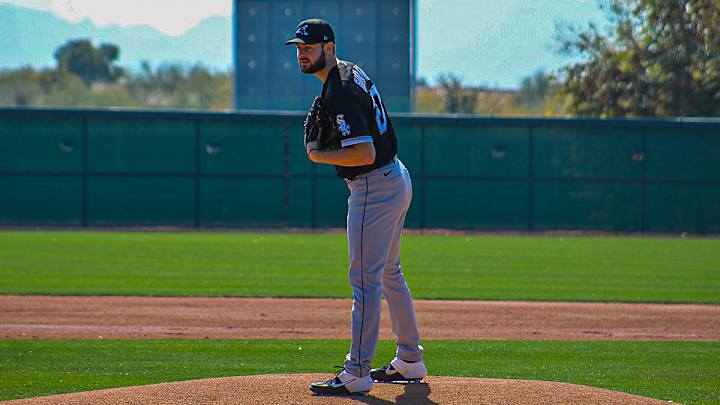The rotation equation

What does 2020 Ricky Renteria have in common with a service academy football playbook?
They both have plenty of options.
Terrible jokes aside, it looks like Ricky Renteria will have options when it comes to starting pitching for the 2020 White Sox — a luxury he didn't have in 2019.
In this 60-game sprint of a season, teams are sure to deploy their pitching staffs in ways we have never seen before. Openers, tandem starts, and six-man rotations are all on the table for many teams throughout baseball. For the White Sox, tandem starts or a six-man rotation seemed to make a lot of sense, with many of their rotation options unproven or coming off of injury.
However, Renteria’s old-school managing style coupled with the loss of Michael Kopech may lead to a more traditional rotation structure. Here are a few possibilities for deploying the White Sox pitching staff in 2020.
Four-man rotation with two-to-four “tandem” starters
1. Lucas Giolito/Jimmy Lambert
2. Dallas Keuchel/Dane Dunning
3. Carlos Rodón/Reynaldo López
4. Dylan Cease/Gio González
PROS In this scenario, Lambert and Dunning serve more as long relievers, utilized if needed but not every time through the rotation, while López and González are part of true tandem starts, with López taking over for Rodón and González for Cease. They would come in at the first sign of trouble, in the fourth, fifth or sixth innings.
These four guys are relatively interchangeable; I just went with righty/lefty pairings to give the batters a different look the second or third time through the order. The main benefit of the four-man rotation is getting extra starts out of Chicago's top arm in Lucas Giolito. Coming into the season, Giolito is far and away the pitcher on the staff, with the best blend of consistency and upside. The four-man rotation allows for Giolito to make 15 starts, whereas a traditional five-man rotation only allows for 12. Additionally, the “tandem” starters will help to keep arms fresh to counteract the effects of pitching on three days’ rest for more than two months.
CONS On paper, this scenario looks great. However, historically, pitchers on three days’ rest have been much less effective. Starts on three days rest usually happen in the playoffs, where pitchers on short rest have recorded a 4.61 ERA across 121 starts since 1995. Considering the fact that pitchers attempting to throw on short rest are usually bonafide aces, this is a noticeably poor result. When taking this into consideration, an entire rotation continuously pitching on three days’ rest could be disastrous. Additionally, the pitchers in the second leg of the tandem would have to deal with a major change in routine and mentality compared to what they experienced starting.
Six-man rotation
1. Lucas Giolito
2. Dallas Keuchel
3. Dylan Cease
4. Carlos Rodón
5. Reynaldo López
6. Gio González
PROS The White Sox currently have six valid options for the rotation, so beginning the season with a six-man rotation would make sense in that regard. It would allow them to see what they have in López and Cease, young exciting arms who need to take a big step forward this year, and Rodón and González, who are both coming off of injuries. After a month of a six-man rotation, performance or injury should make the rotation picture more clear. An added benefit of the six-man is the extra day of rest for the starters while they are still getting ramped up.
CONS In a 60-game sprint of a season, each game is more important than ever. The White Sox don’t necessarily have time to “see what they have,” they need their best guys to be on the mound as often as possible. A six-man rotation would limit the number of starts the top of the rotation gets to 10 or 11. With the Sox already underdogs in the Central this year, they may have to take some chances, and a six-man rotation seems better suited for the long-term organizational development standpoint than the short-term, two-month stretch that will determine the teams' 2020 fate.
Five-man rotation
1. Lucas Giolito
2. Dallas Keuchel
3. Dylan Cease
4. Reynaldo López
5. Gio González/Carlos Rodón
Other Options- Dunning, Lambert
PROS Despite all of the options at Chicago's disposal, the traditional five-man rotation structure makes the most sense, with the caveat of a González-Rodón tandem start. Although they are both lefties, which isn't ideal, this will allow them to minimize stress on their arms as they return from injury.
I would also slightly modify the traditional “every fifth game” rotation by using the schedule's six off-days to our advantage. Every off-day provides the opportunity to skip a pitcher in the rotation (whoever may be struggling at the time) while maintaining standard rest for the rest of the rotation. Skipping a guy each off-day will get Giolito back out there one day sooner on normal rest rather than having the extra day of rest due to the off-day. This should buy him one, maybe two, extra starts over the course of the season. The result is Giolito will get almost as many starts as a four-man rotation while still maintaining traditional rest between outings. If Cease or López struggle, González can quickly be inserted into the rotation, and the Sox will be able to use the electric stuff of Cease/López in the back end of their bullpen, where it should play up to a degree.
CONS The only negative about this scenario is that it is the least creative. The Sox really have nothing to lose this year, as the Twins are still projected to win the Central. The nontraditional format of this season will no doubt encourage creativity and experimentation, so sticking to a five-man rotation almost feels too safe.
However, there is a reason that the five-man rotation has been the standard throughout modern history, and with the Sox pitching staff, sticking with it makes the most sense. While it may not give starters time to fully ramp up to 100+ pitches, the expanded rosters should give the Sox enough arms to pick up the slack in relief the first few times through. Injury or underperformance can obviously throw a wrench in this plan, but that can happen with any of these scenarios.
Other Notes
New extra-inning rule
Baseball is implementing a new extra-inning rule in this shortened 2020 season. Each inning of extras will start with a runner on second base, in an effort to avoid games stretching too long. All complaints about this rule aside (what is this, 12U summer ball?), this rule could potentially hurt the White Sox. In this new format, strikeouts become paramount. A strikeout with a runner on second and no outs is huge, because putting the ball in play (specifically, hitting behind the runner) may give a chance for the runner to advance to third with less than two outs. Strikeouts are again critical with a runner on third and less than two outs, as simply putting the ball in play will oftentimes get the runner home.
In an extra-inning game, most teams have high-strikeout guys that they can bring out of the bullpen to get a big K. However, the White Sox top bullpen arms all get by on weak contact rather than high strikeout totals. Aaron Bummer is a ground ball machine, Alex Colomé had the second-lowest K/9 of all closers in 2019, and Steve Cishek is a crafty sidewinder. Other pen options are Jimmy Cordero and Evan Marshall. All five of these guys struck out fewer than one batter per inning, a rarity among back-end relievers. And offensively, the White Sox finished with the sixth-most strikeouts in baseball in 2019.
Based on historical data, in a 60-game season, teams should average just more than five extra-inning games. Even one or two extra losses during these games due to an ill-timed strikeout (or lack thereof, on the pitching side) could be huge for Chicago's playoff chances.
A glass half-full perspective on the Kopech news
The White Sox were dealt a tough blow to their 2020 postseason aspirations when Michael Kopech announced that he would be opting out of the 2020 season. Hopefully Kopech is doing well mentally, as that comes first and foremost. Business-wise, however, this could be a blessing in disguise for the White Sox. Kopech will not get credit for a year of service time this year, so the White Sox will have control through 2025 instead of 2024.
I would rather have Kopech for an extra 162-game season in the middle of the White Sox’s playoff window, rather than for a 60-game “asterisk” season in which the Sox still may be too young to seriously compete for a championship.
